
The Amazing Ames Room (a) A diagram showing the actual proportions of the Ames room reveals its secrets. The sides of the room form a trapezoid with parallel sides but a back wall that is way off square. The uneven floor makes the room’s height in the far back corner shorter than the other. Add misleading cues such as specially designed windows and flooring, position the room’s occupants in each far corner and you are ready to lure an unsuspecting observer. (b) Looking into the Ames room through the viewing port with only one eye, the observer infers a normal size– p—
(B) PHIL SCHERMEISTER/CORBIS